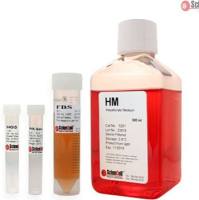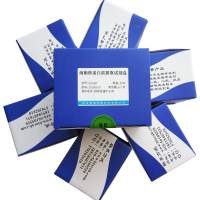根分生细胞核蛋白质提取
丁香园
2658
1. 前言
用蛋白质组学鉴别植物蛋白质经常遇到植物基因组序列数据量不够的问题。只有拟南芥和水稻被全部测序,这就意味着只有极少情况下可以专门使用质谱分析法(MS) 鉴别蛋白质,通常是用拟南芥这种模式植物 [ 1,2] 。在其他情况下,MS 测序可以同时用 Edman 测序 [ 3,4] 来测定氨基酸末端序列。另一种方法是在用光谱分析法测得末端序列后鉴别蛋白质,然后和已知序列的基因比对 [ 1,3,5,6] 。总的来说,用已知基因组序列的模式植物研究极大推进了植物蛋白质组学。
我们这里描述的这种方法适用于未知基因序列的植物。集中研究少数蛋白质,这些蛋白质存在于已知功能的不同馏分中。因此,我们研究亚细胞结构的蛋白质组学,即细胞核研究,并且将它分为亚蛋白质组进行研究。
很明显,第一步是获取生物材料以用来研究。因为我们感兴趣于研究核蛋白相关的细胞增殖,所以我们选择根尖分生组织细胞群。材料是匀浆后纯化细胞器(此处为细胞核)。从分生组织细胞中分离细胞核比较容易,因为这类细胞核占据很大体积。
从这些被纯化的细胞核中,通过逐渐增加缓冲液离子强度而逐渐增大蛋白溶解度,依次得到的蛋白质组分,最后得到一系列的亚蛋白质组 [8] 。首先得到漂洗组分包含核膜和残留细胞骨架的蛋白质。随后得到的镏分可溶解在含有 EDTA 的低离子强度缓冲液中,此溶液被称为 S2 , 从这里我们得到溶解性最好的核蛋白质,即核糖核蛋白。第三步,在用糖核酸酶反应后,我们会提取到染色质蛋白质。最后的两份馏分中含有细胞核基质蛋白质,先溶解在高盐缓冲液中,然后得到不溶的沉淀。这些不溶性沉淀和含有 RNA 的微丝网有关系 [ 10] 。
在提取一系列的蛋白质之后,每份馏分都在适合的缓冲液里溶解,以便于单向电泳或双向凝胶分离蛋白质。事实上,双向凝胶可以用于各种处理情况下的细胞蛋白质表达情况比较,如不同生理状态细胞,或某种的突变体或转基因植株,或药物处理,或受到不同刺激物刺激。特别是我们已经使用这种方法鉴定细胞增殖过程中的核蛋白质 [ 11] ,以及测定在国际空间站中由微重力而引起的表达变化 [ 12] 。
2. 方法
2.1 植物材料和提取介质
( 1 ) 萌芽:为了让洋葱鳞茎出根,使用圆桶状玻璃器皿,里面装过滤水(milli- RO4水 ;Millipore, Bedford MA) 。
( 2 ) 提取介质:被收集的植物材料置于提取介质中。提取介质是为稳定亚细胞馏分的混合试剂。依照 Greimer 和 Deltoid [13」所述并稍作改动:2% 阿拉伯树胶(Sigma) 、1.25% Ficoll (Sigma) 、2.5% 硫酸葡萄聚糖(Fluka) 、25 mmol/L Tris-HCl ( pH 7.4)、0.5 mmol/L EDTA、2.5 mmol/L MgCl2、4 mmol/L 正辛醇、8 mmol/L β- 疏基乙醇 ( Sigma) 、6.8 mmol/L 二乙基焦磷酰胺(DEPC) (Sigma) 、30% 甘油及蛋白酶抑制剂 [ 含有 1 μg/ml 抑肽酶(aprotinin) 、1 μg/ml 胃蛋白酶抑制剂(pepstatin) 、1 μg/ml 亮抑酶肽(leupeptin) 、0.1 mmol/L PMSF ] ,所有药品都来自于 Sigma ( 见注释 1 和注释 2) 。注意:媒介中的两种成分—— DEPC 和 β-巯基乙醇是有毒的,需要在通风橱中进行准备,并需要戴化学防护手套。
2.2 细胞核的提纯
( 1 ) 样品匀浆:使用高速分散搅拌器(IKA 、Labortechnik、Staufen、Germany),并通过 3 层尼龙布过滤,3 层尼龙布网眼直径分别为 100 μm,50 μm 和 30 μm。
( 2 ) 保存提纯的细胞核:一旦细胞核被提纯出来,它们需要保存在细胞核贮存缓冲液中(NSB),它包含 10 mmol/L Tris-HCl ( pH 7.4 ) 、10 mmol/L HEPES、10 mmol/L KCl、2 mmol/L MgCl2、 4 mmol/L 正辛醇、0.1 mmol/L CaCl2、0.24 mol/L 蔗糖、0.5 mmol/L 亚精胺(Sigma)、0.15 mmol/L 精胺(Sigma)、0.02% 叠氮钠,并加入蛋白酶抑制剂混合物,见 7.2.1。
( 3 ) 这种缓冲液能够被贮存在 4°C 条件下数月,需要防止真菌污染。蛋白酶抑制剂在使用之前方可加入,不要在准备溶剂的时候加入。
2.3 细胞核蛋白质的分离和提取
所有溶液都使用蛋白酶抑制剂。
( 1 ) 含有膜和残留细胞骨架(图 8-1,泳道 M):第一份馏分用 NSB 提取,NSB 含有 1% ( V/V ) Nonidet NP-40 (Roche) 和 0.5% ( V/V ) 脱氧胆酸钠(Sigma) 。
( 2 ) 可溶性馏分(S2 ) (图 8-1,S2 ):第二份馏分用低离子强度缓冲液提取,这种缓冲液含有 10 mmol/L Tris-HCl ( pH 8.0 ) 和 1 mmol/L EDTA。
( 3 ) 染色质馏分(图 8-1, Chr):为了提取第三份馏分,使用的缓冲液由 NSB 组成 ,其中含有 100 μg/ml 无 RNA 酶的 DNA 酶 I (Sigma) 和 0.5% Triton X-100。在 DNA 酶解之后,加入 0.25 mol/L 硫酸铵。
( 4 ) 高盐馏分(图 8-1,HS):用含有 2 mol/L NaCl 的 NSB 提取。
( 5 ) 不溶性馏分或细胞核基质馏分( 图 8-1,NM ):只能溶解于尿素缓冲液,其含有 20 mmol/L MES ( pH 6.6)、1 mmol/L EGTA、0.1 mmol/L MgCl2、1% β-巯基乙醇、0.02% 叠氮钠、0.5% Triton X-100、8 mol/L 尿素、2 mol/L 硫脲。缓冲液可以在 4°C 条件下稳定保存数月,但是尿素会遇冷结晶,所以在使用之前可以放置在室温下,或在使用时轻微加热,不要超过 37°C。

2.4 为 SDS-PAGE 和双向电泳准备蛋白质
( 1 ) 沉淀步骤:用 7% TCA 沉淀每份馏分中的蛋白质。沉淀用乙醇/乙醚 3 : 1 ( V/V)漂洗。
( 2 ) 准备 SDS-PAGE:如果蛋白质需要用 SDS-PAGE 分离,蛋白质重悬于 Laemmli 缓冲液中。Laemmli 缓冲液由 10% 甘油,0.2 mol/L Tris-HCl,pH 6.8,0.002% 溴酚蓝(Bio- Rad),4% SDS, 5% β-巯基乙醇。
( 3 ) 准备双向电泳:干燥的细胞核蛋白质组分在重悬缓冲液中再次溶解。重悬缓冲液含有 40 mmol/L Tris-HCl,2 mol/L 硫脲,7 mol/L 尿素,4% Triton X-100,100 mmol/L DTT,2% 载体两性电解质(Bio- Rad) ( pH 4~7 载体两性电解质以 2 : 1 的比率混合 pH 3~10 两性电解质),0.001% 溴酚蓝(Bio- Rad) 。缓冲液可以不加入 DTT 和两性电解质,保存在室温下,这两样药品应该在蛋白质加载到凝胶之前加入缓冲液。
( 4 ) 蛋白质浓度测定。使用考马斯亮蓝法(Bio- Rad) 。光密度可以用分光光度计在波长 595 nm 测量出来。机器用含有 750 μl 水,250 μl Bradford 试剂和 1 μl 电泳缓冲液 ( Laemmli 或 Rehydration) ,不含有蛋白质和溴酚蓝的溶液调整到零。获得的结果和标准曲线进行比对。标准曲线由已知浓度 BSA 的作出,变化范围从 1~140 μg/ml。
参考文献
1. Gallardo, K., Job, C., Groot, S. P. C., et al. (2002) Proteomics of A r a b id o p s is seedgermination. A comparative study of wild-type and gibberellin-deficient seeds.P la n t P h ysio l. 129, 823-837.
2 . Gallardo, K., Job, C., Groot, S. P. C., et al. (2001) Proteomic analysis ofA r a b id o p s is seed germination and priming. P la n t P h y s io l. 126, 835-848.
3. Prime, T. A., Sherrier, D. J., Mahon, P., Packman, L. C., and Dupree, P. (2000) Aproteomic analysis of organelles from A r a b id o p s is th a lia n a . E le c tr o p h o r e s is 21,3488-3499.
4. Shen, S., Jing, Y., and Kuang, T. (2003) Proteomics approach to identify wound-response related proteins from rice leaf sheath. P r o te o m ic s 3, 527-535.
5. Mathesius, U., Keijzes, G., Natera, S. H. A., Weinman, J. J., Djordevic, M. A.,and Rolfe, B. G. (2001) Establishment of a root proteome reference map for themodel legume M e d ic a g o tr u n c a tu la using the expressed sequence tag databasefor peptide mass fingerprinting. P r o te o m ic s 1, 1424-1440.
6. Chivasa, S., Ndimba, B.K., Simon, W.J., et al. (2002) Proteomic analysis of theA r a b id o p s is th a lia n a cell wall. E le c tr o p h o r e s is 23, 1754-1765.
7. Shevchenko, A., Jensen, O.N., Podtelejnikov, A.V., et al. (1996) Linking genomeand proteome by mass spectrometry: large-scale identification of yeast proteinsfrom two dimensional gels. P ro c. N a tl. A ca d . S ci. U SA 93, 14,440-14,445.
8 . Busch, H., Ballal, N. R., Rao, M. R. S., Choi, Y. C., and Rothblum, L. I. (1978)Factors affecting nucleolar rDNA readouts, in T h e C e ll N u c le u s , vol. 5, C h r o m a tin , part B. (Busch, H., ed.), Academic Press, New York, pp. 416-468.
9. Bourbon, H. M., Bugler, B., Caizergues-Ferrer, M., and Amalric, F. (1983) Roleof phosphorylation on the maturation pathways of 100 KD nucleolar protein.F E B S L e tt. 155, 218-222.
10 . He, D., Nickerson, J. A., and Penman, S. (1990) Core filaments of the nuclearmatrix. / . C e ll B io l. 110, 569-580.
11. Gonzalez-Camacho, F. and Medina, F. J. (2004) Identification of specific plant nucleolar phosphoproteins in a functional proteomic analysis. P ro teo m ics 4, 407^417.
12 . Matfa, I., Gonzalez-Camacho, F., Marco, R., Kiss, J.Z., Gasset, G., and Medina,F.J. (2005) Nucleolar structure and proliferation activity o f A r a b id o p s is root cellsfrom seedlings germinated on the International Space Station. A d v. S p a c e R es.36,1244-1253.
13. Greimers, R. and Deltour, R. (1981) Organization of transcribed andnontranscribed chromatin in isolated nuclei of Z e a m a y s root cells. E u r. J. C e llB io l. 23, 303-311.
1 4 . De Career, G., Cerdido, A., and Medina, F. J. (1997) NopA64, a novel nucleolarphosphoprotein from proliferating onion cells, sharing immunological determinants with mammalian nucleolin. P la n ta 201, 487-495.
15. De Career, G., Lallena, M. J., and Correas, I. (1995) Protein 4.1 is a component ofthe nuclear matrix of mammalian cells. B io c h e m . J. 3 12, 871-877.
16. Schnapp, A., Pfliderer, C., Rosenbauer, H., and Grummt, I. (1990) A growth-dependent transcription initiation factor (TIF-IA) interacting with RNA polymerase I regulates mouse ribosomal RNA synthesis. E M B O J. 9, 2857-2863.
17. Dunham, V. L. and Bryant, J. A. (1983) Nuclei, in I s o la tio n o f M e m b r a n e s a n dO r g a n e lle s fr o m P la n t C e lls (Hall, J. L. and Moore, L., eds.), Academic Press,London, pp. 237-275.
18 . Bradford, M. M. (1976) A rapid and sensitive method for the quantitation ofmicrogram quantities of protein utilizing the principle of protein-dyebinding.A n a l. B io c h em .7, 248-254.
用蛋白质组学鉴别植物蛋白质经常遇到植物基因组序列数据量不够的问题。只有拟南芥和水稻被全部测序,这就意味着只有极少情况下可以专门使用质谱分析法(MS) 鉴别蛋白质,通常是用拟南芥这种模式植物 [ 1,2] 。在其他情况下,MS 测序可以同时用 Edman 测序 [ 3,4] 来测定氨基酸末端序列。另一种方法是在用光谱分析法测得末端序列后鉴别蛋白质,然后和已知序列的基因比对 [ 1,3,5,6] 。总的来说,用已知基因组序列的模式植物研究极大推进了植物蛋白质组学。
我们这里描述的这种方法适用于未知基因序列的植物。集中研究少数蛋白质,这些蛋白质存在于已知功能的不同馏分中。因此,我们研究亚细胞结构的蛋白质组学,即细胞核研究,并且将它分为亚蛋白质组进行研究。
很明显,第一步是获取生物材料以用来研究。因为我们感兴趣于研究核蛋白相关的细胞增殖,所以我们选择根尖分生组织细胞群。材料是匀浆后纯化细胞器(此处为细胞核)。从分生组织细胞中分离细胞核比较容易,因为这类细胞核占据很大体积。
从这些被纯化的细胞核中,通过逐渐增加缓冲液离子强度而逐渐增大蛋白溶解度,依次得到的蛋白质组分,最后得到一系列的亚蛋白质组 [8] 。首先得到漂洗组分包含核膜和残留细胞骨架的蛋白质。随后得到的镏分可溶解在含有 EDTA 的低离子强度缓冲液中,此溶液被称为 S2 , 从这里我们得到溶解性最好的核蛋白质,即核糖核蛋白。第三步,在用糖核酸酶反应后,我们会提取到染色质蛋白质。最后的两份馏分中含有细胞核基质蛋白质,先溶解在高盐缓冲液中,然后得到不溶的沉淀。这些不溶性沉淀和含有 RNA 的微丝网有关系 [ 10] 。
在提取一系列的蛋白质之后,每份馏分都在适合的缓冲液里溶解,以便于单向电泳或双向凝胶分离蛋白质。事实上,双向凝胶可以用于各种处理情况下的细胞蛋白质表达情况比较,如不同生理状态细胞,或某种的突变体或转基因植株,或药物处理,或受到不同刺激物刺激。特别是我们已经使用这种方法鉴定细胞增殖过程中的核蛋白质 [ 11] ,以及测定在国际空间站中由微重力而引起的表达变化 [ 12] 。
2. 方法
2.1 植物材料和提取介质
( 1 ) 萌芽:为了让洋葱鳞茎出根,使用圆桶状玻璃器皿,里面装过滤水(milli- RO4水 ;Millipore, Bedford MA) 。
( 2 ) 提取介质:被收集的植物材料置于提取介质中。提取介质是为稳定亚细胞馏分的混合试剂。依照 Greimer 和 Deltoid [13」所述并稍作改动:2% 阿拉伯树胶(Sigma) 、1.25% Ficoll (Sigma) 、2.5% 硫酸葡萄聚糖(Fluka) 、25 mmol/L Tris-HCl ( pH 7.4)、0.5 mmol/L EDTA、2.5 mmol/L MgCl2、4 mmol/L 正辛醇、8 mmol/L β- 疏基乙醇 ( Sigma) 、6.8 mmol/L 二乙基焦磷酰胺(DEPC) (Sigma) 、30% 甘油及蛋白酶抑制剂 [ 含有 1 μg/ml 抑肽酶(aprotinin) 、1 μg/ml 胃蛋白酶抑制剂(pepstatin) 、1 μg/ml 亮抑酶肽(leupeptin) 、0.1 mmol/L PMSF ] ,所有药品都来自于 Sigma ( 见注释 1 和注释 2) 。注意:媒介中的两种成分—— DEPC 和 β-巯基乙醇是有毒的,需要在通风橱中进行准备,并需要戴化学防护手套。
2.2 细胞核的提纯
( 1 ) 样品匀浆:使用高速分散搅拌器(IKA 、Labortechnik、Staufen、Germany),并通过 3 层尼龙布过滤,3 层尼龙布网眼直径分别为 100 μm,50 μm 和 30 μm。
( 2 ) 保存提纯的细胞核:一旦细胞核被提纯出来,它们需要保存在细胞核贮存缓冲液中(NSB),它包含 10 mmol/L Tris-HCl ( pH 7.4 ) 、10 mmol/L HEPES、10 mmol/L KCl、2 mmol/L MgCl2、 4 mmol/L 正辛醇、0.1 mmol/L CaCl2、0.24 mol/L 蔗糖、0.5 mmol/L 亚精胺(Sigma)、0.15 mmol/L 精胺(Sigma)、0.02% 叠氮钠,并加入蛋白酶抑制剂混合物,见 7.2.1。
( 3 ) 这种缓冲液能够被贮存在 4°C 条件下数月,需要防止真菌污染。蛋白酶抑制剂在使用之前方可加入,不要在准备溶剂的时候加入。
2.3 细胞核蛋白质的分离和提取
所有溶液都使用蛋白酶抑制剂。
( 1 ) 含有膜和残留细胞骨架(图 8-1,泳道 M):第一份馏分用 NSB 提取,NSB 含有 1% ( V/V ) Nonidet NP-40 (Roche) 和 0.5% ( V/V ) 脱氧胆酸钠(Sigma) 。
( 2 ) 可溶性馏分(S2 ) (图 8-1,S2 ):第二份馏分用低离子强度缓冲液提取,这种缓冲液含有 10 mmol/L Tris-HCl ( pH 8.0 ) 和 1 mmol/L EDTA。
( 3 ) 染色质馏分(图 8-1, Chr):为了提取第三份馏分,使用的缓冲液由 NSB 组成 ,其中含有 100 μg/ml 无 RNA 酶的 DNA 酶 I (Sigma) 和 0.5% Triton X-100。在 DNA 酶解之后,加入 0.25 mol/L 硫酸铵。
( 4 ) 高盐馏分(图 8-1,HS):用含有 2 mol/L NaCl 的 NSB 提取。
( 5 ) 不溶性馏分或细胞核基质馏分( 图 8-1,NM ):只能溶解于尿素缓冲液,其含有 20 mmol/L MES ( pH 6.6)、1 mmol/L EGTA、0.1 mmol/L MgCl2、1% β-巯基乙醇、0.02% 叠氮钠、0.5% Triton X-100、8 mol/L 尿素、2 mol/L 硫脲。缓冲液可以在 4°C 条件下稳定保存数月,但是尿素会遇冷结晶,所以在使用之前可以放置在室温下,或在使用时轻微加热,不要超过 37°C。

2.4 为 SDS-PAGE 和双向电泳准备蛋白质
( 1 ) 沉淀步骤:用 7% TCA 沉淀每份馏分中的蛋白质。沉淀用乙醇/乙醚 3 : 1 ( V/V)漂洗。
( 2 ) 准备 SDS-PAGE:如果蛋白质需要用 SDS-PAGE 分离,蛋白质重悬于 Laemmli 缓冲液中。Laemmli 缓冲液由 10% 甘油,0.2 mol/L Tris-HCl,pH 6.8,0.002% 溴酚蓝(Bio- Rad),4% SDS, 5% β-巯基乙醇。
( 3 ) 准备双向电泳:干燥的细胞核蛋白质组分在重悬缓冲液中再次溶解。重悬缓冲液含有 40 mmol/L Tris-HCl,2 mol/L 硫脲,7 mol/L 尿素,4% Triton X-100,100 mmol/L DTT,2% 载体两性电解质(Bio- Rad) ( pH 4~7 载体两性电解质以 2 : 1 的比率混合 pH 3~10 两性电解质),0.001% 溴酚蓝(Bio- Rad) 。缓冲液可以不加入 DTT 和两性电解质,保存在室温下,这两样药品应该在蛋白质加载到凝胶之前加入缓冲液。
( 4 ) 蛋白质浓度测定。使用考马斯亮蓝法(Bio- Rad) 。光密度可以用分光光度计在波长 595 nm 测量出来。机器用含有 750 μl 水,250 μl Bradford 试剂和 1 μl 电泳缓冲液 ( Laemmli 或 Rehydration) ,不含有蛋白质和溴酚蓝的溶液调整到零。获得的结果和标准曲线进行比对。标准曲线由已知浓度 BSA 的作出,变化范围从 1~140 μg/ml。
参考文献
1. Gallardo, K., Job, C., Groot, S. P. C., et al. (2002) Proteomics of A r a b id o p s is seedgermination. A comparative study of wild-type and gibberellin-deficient seeds.P la n t P h ysio l. 129, 823-837.
2 . Gallardo, K., Job, C., Groot, S. P. C., et al. (2001) Proteomic analysis ofA r a b id o p s is seed germination and priming. P la n t P h y s io l. 126, 835-848.
3. Prime, T. A., Sherrier, D. J., Mahon, P., Packman, L. C., and Dupree, P. (2000) Aproteomic analysis of organelles from A r a b id o p s is th a lia n a . E le c tr o p h o r e s is 21,3488-3499.
4. Shen, S., Jing, Y., and Kuang, T. (2003) Proteomics approach to identify wound-response related proteins from rice leaf sheath. P r o te o m ic s 3, 527-535.
5. Mathesius, U., Keijzes, G., Natera, S. H. A., Weinman, J. J., Djordevic, M. A.,and Rolfe, B. G. (2001) Establishment of a root proteome reference map for themodel legume M e d ic a g o tr u n c a tu la using the expressed sequence tag databasefor peptide mass fingerprinting. P r o te o m ic s 1, 1424-1440.
6. Chivasa, S., Ndimba, B.K., Simon, W.J., et al. (2002) Proteomic analysis of theA r a b id o p s is th a lia n a cell wall. E le c tr o p h o r e s is 23, 1754-1765.
7. Shevchenko, A., Jensen, O.N., Podtelejnikov, A.V., et al. (1996) Linking genomeand proteome by mass spectrometry: large-scale identification of yeast proteinsfrom two dimensional gels. P ro c. N a tl. A ca d . S ci. U SA 93, 14,440-14,445.
8 . Busch, H., Ballal, N. R., Rao, M. R. S., Choi, Y. C., and Rothblum, L. I. (1978)Factors affecting nucleolar rDNA readouts, in T h e C e ll N u c le u s , vol. 5, C h r o m a tin , part B. (Busch, H., ed.), Academic Press, New York, pp. 416-468.
9. Bourbon, H. M., Bugler, B., Caizergues-Ferrer, M., and Amalric, F. (1983) Roleof phosphorylation on the maturation pathways of 100 KD nucleolar protein.F E B S L e tt. 155, 218-222.
10 . He, D., Nickerson, J. A., and Penman, S. (1990) Core filaments of the nuclearmatrix. / . C e ll B io l. 110, 569-580.
11. Gonzalez-Camacho, F. and Medina, F. J. (2004) Identification of specific plant nucleolar phosphoproteins in a functional proteomic analysis. P ro teo m ics 4, 407^417.
12 . Matfa, I., Gonzalez-Camacho, F., Marco, R., Kiss, J.Z., Gasset, G., and Medina,F.J. (2005) Nucleolar structure and proliferation activity o f A r a b id o p s is root cellsfrom seedlings germinated on the International Space Station. A d v. S p a c e R es.36,1244-1253.
13. Greimers, R. and Deltour, R. (1981) Organization of transcribed andnontranscribed chromatin in isolated nuclei of Z e a m a y s root cells. E u r. J. C e llB io l. 23, 303-311.
1 4 . De Career, G., Cerdido, A., and Medina, F. J. (1997) NopA64, a novel nucleolarphosphoprotein from proliferating onion cells, sharing immunological determinants with mammalian nucleolin. P la n ta 201, 487-495.
15. De Career, G., Lallena, M. J., and Correas, I. (1995) Protein 4.1 is a component ofthe nuclear matrix of mammalian cells. B io c h e m . J. 3 12, 871-877.
16. Schnapp, A., Pfliderer, C., Rosenbauer, H., and Grummt, I. (1990) A growth-dependent transcription initiation factor (TIF-IA) interacting with RNA polymerase I regulates mouse ribosomal RNA synthesis. E M B O J. 9, 2857-2863.
17. Dunham, V. L. and Bryant, J. A. (1983) Nuclei, in I s o la tio n o f M e m b r a n e s a n dO r g a n e lle s fr o m P la n t C e lls (Hall, J. L. and Moore, L., eds.), Academic Press,London, pp. 237-275.
18 . Bradford, M. M. (1976) A rapid and sensitive method for the quantitation ofmicrogram quantities of protein utilizing the principle of protein-dyebinding.A n a l. B io c h em .7, 248-254.







